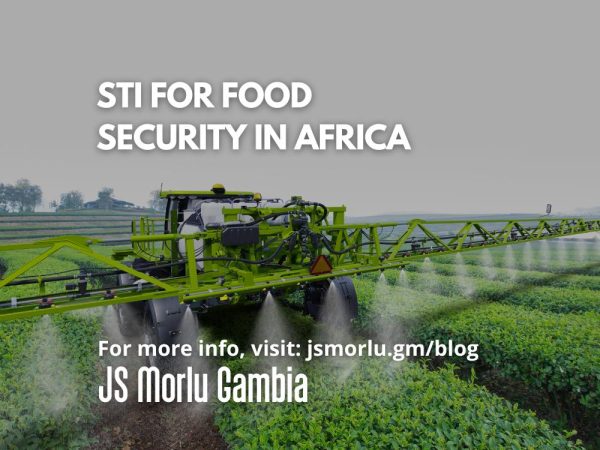In Africa, food systems transformation is required to ensure adequate incomes for producers and enable access to affordable, healthy diets while managing increasing food demand from growing and rapidly urbanising populations:
- In 2019, 12 % of people in Africa could not afford a calorie-sufficient diet in 2019, while 56% were not able to afford a nutrient-adequate diet and 80% could not afford a healthy diet;
- Over-reliance on imports for staple food is a risk that threatens long-term food systems resilience;
- It is estimated that by 2050 Africa’s population will increase 2.5-fold and the demand for cereals is likely to triple. This will have consequences for agriculture and food systems, including pressure on land, water and other natural resources.
Science, technology and innovation (STI) can help support food system development in ways that protect resources, provide livelihoods opportunities, improve incomes across the system, and at the same time, deliver more nutritious and healthy diets.
Improving production systems and restoring degraded systems (including soil quality).
A holistic and integrated strategy is needed that focuses on raising soil organic matter and improving moisture retention. The development of next-generation crop varieties should simultaneously select beneficial characteristics in the plant and the microbiome to improve soil fertility and crop yields.
Investment and innovation will be necessary for low-cost yet efficient irrigation options to mitigate the impact of water scarcity and expand the availability of diverse foods year-round (e.g. hydroponic production, recycling wastewater, promoting the use of renewable energies in water desalination for agriculture use).
Livestock genetic improvement programmes, interventions to increase carbon sequestration in grasslands and improved management of grazing lands could significantly increase productivity and reduce greenhouse gas emissions. The available genetic variability of forage grasses and legumes plants is still largely untapped, although it could offer a wide array of benefits (e.g. higher livestock and crop productivity, restoration of degraded land, improvement of soil fertility, the inhibition of nitrification in the soil, a year-round supply of feedstock). Emerging challenges in animal health include improving resistance to disease and combating the misuse of antibiotics in animal production systems.
Aquaculture production in Africa expanded at an average annual rate of 11.7% between 2000 and 2012 (nearly twice the global average rate of 6.2%). Determining the genetic basis of feed efficiency in fish with potential for commercial production in Africa is an important research objective.
Optimising the utilisation of indigenous crops, livestock, fish and underutilised foods. There is a need to collect and categorise these underutilised crops and wild populations of important plant species and combine these with modern molecular breeding technologies.
Although not widely adopted in Africa, biotechnology offers many opportunities to improve productivity, overcome abiotic (such as drought) and biotic stresses (diseases and pests), and save time and effort for farmers in Africa. Some examples of the application of biotechnology in Africa include the development of disease-resistant bananas and cassava; vitamin enriched bananas and nitrogen-efficient rice in Uganda; insect tolerant cowpea in Nigeria, Niger and Ghana; and drought-tolerant maize in Kenya
Innovation in the processing and packaging of foods.
Postharvest handling and technologies offer opportunities to reduce food losses and waste, particularly in the African context where cold chains and refrigeration are largely missing and seasonality leads to gluts and shortages of perishable goods. More investment is also needed in developing and making available solar driers and agro-processing equipment such as shellers and de-pulpers.
Food processing has the potential to contribute to the reduction of postharvest losses, enhancement of food safety and quality, creation of diversity, and stabilisation of food supply, reducing the prevalence of seasonal hunger and improving market access. It is also possible to develop nutrient-and energy-enhanced foods.
Food safety is critical to the advancement of foods systems. Poverty exacerbates the problem since it leads to overdependence on one foodstuff and may lead to the consumption of contaminated foods because of the lack of alternatives. The lack of suitable regulations to prevent food contamination, or their poor enforcement when regulations exist (often applied to export goods, but not the domestic market) combined with the low levels of capacity for detecting food toxins, are serious concerns. Rapid and cheap out-of-laboratory analytical techniques designed for field conditions can offer solutions to these problems.
More research and development is needed in packaging solutions to extend the shelf life of food, thereby reducing enzymatic activity and the growth of microorganisms and preventing moisture loss and decay.
Improving human nutrition, health and productivity. Making more nutritious food options available to a wide range of consumers is another pathway to influencing nutritional outcomes. This can include public and private sector investment in research and innovation of technologies and processes, such as gene sequencing technologies, wealth of indigenous food, and food fortification.
A data revolution for greater access to information and transparent monitoring and accountability systems.
ICT innovations also offer multiple opportunities for improving and optimising food systems that could support the establishment of “big data” systems, analysis and reporting of cross-sectoral data, and monitoring and evaluation of implementation. ICT technologies (e.g. cloud computing, mobile technology, satellite Earth Observations) can play an important role in monitoring contexts such as climate change, disease patterns and early warning systems. Mobile technology could also be used to disseminate of knowledge, to overcome many trade and market-related information challenges, to access financial services.
Original Source: Knowledge4Policy
